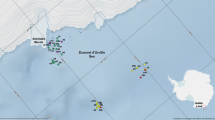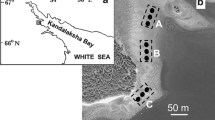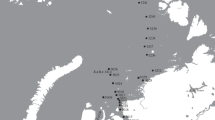Abstract
Harpacticoid copepod assemblages from an intertidal sandflat in the Jade Bay (German Bight, North Sea) were investigated during a snapshot study, uncovering a relatively high small-scale organismic diversity: 1952 adult Harpacticoida of 32 species were recorded, belonging to 19 genera and 13 families. With 1232 adult specimens (63.1 %), Ectinosomatidae were the most abundant family, containingPseudobradya minor (T. & A.Scott) as the dominating species (57.4 %). For five species,Dactylopusia vulgaris (Sars),Remanea arenicola Klie,Mesochra pygmaea (Claus),Arenopontia subterranea Kunz, andEnhydrosoma gariene Gurney, the distributional range along the German coast line was extended to the area west of the river Elbe. Two species,Arenosetella tenuissima (Klie) andPseudobradya beduina Monard, were recorded for the first time in the Jade region. Most species recorded in our study are typical inhabitants of interridal sandy and/or muddy environments.
Taking into account different aspects of diversity (species richness: species numbers, estimated species numbers by Jack-knife 1 and 2, species richness plots; heterogeneity: Shannon index, rarefaction curves; phylogenetic/taxonomic relationship: taxonomic distinctness) we found only minor diversity differences between four investigated small spatial scales (circles from 18 cm to 20 m diameter). Hypothesis [a] stating increasing diversity with increasing scale had to be rejected. This unexpected result could be caused by the presence of a mosaic of more or less randomly arranged micropatches of species over the sampling domain. Obviously, all citcles were more or less within the range of a single ecological scale. A slight diversity change at the 20 m scale, mainly based on lower species density, may be due to changing tide, or to a beginning overlap of small-scale random micropatches by a larger-scale environmental pattern. Since we found only minor diversity changes from the smallest (centimetres) to the largest investigated scale (tens of metres), biotic and/or abiotic factors and processes acting at spatial scales of centimetres are assumed to be of special relevance for intertidal harpacricoid diversity.
Hypothesis [b] of no significant harpacticoid assemblage differences between the investigated scales was tested by ANOSIM for two similarity measures, leading to different results. Cosine similarity revealed no significant difference in assemblage composition between all possible pairwise combinations of circles, whereas [b] had to rejected for Bray-Curtis dissimilarity which produced significant results for two pairs (A/D, C/D). The difference between the test results is suggested to be caused by a lower species density in circle D, since Bray-Curtis dissimilarity is separating similar monitoring units if the difference is only due to multiples in abundance (Pfeifer et al. 1998).
Similar content being viewed by others
References
Achtziger, R., Nigmann, U. &Zwölfer, H. (1992): Rarefaction-Methoden und ihre Einsatzmöglichkeiten bei der zooökologischen Zustandsanalyse und Bewertung von Biotopen. — Zeitschrift für Ökologie und Naturschutz,1: 89–105.
Ansari, Z.A. &Gauns, M.U. (1996): A quantitative analysis of fine scale distribution of intertidal meiofauna in response to food resources. — Indian Journal of Marine Science,25 (3): 259–263.
Armonies, W. &Reise, K. (2000): Faunal diversity across a sandy shore. — Marine Ecology Progress Series,196: 49–57.
Azovsky, A.I. (2000): Concept of scale in marine ecology: linking the words or the worlds?. — Web Ecology,1:28–34.
Azovsky, A.I., Chertoprood, E.S., Saburova, M.A. &Polikarpov, I. G. (2004): Spatio-temporal variability of micro- and meiobenthic communities in a White Sea intertidal sandflat. — Estuarine Coastal and Shelf Science,60: 663–671.
Bierkens, M.F.P., Finke, P.A. &Willigen, P.D. (2000): Upscaling and downscaling methods for environmental research. — 190 pp.; Dordrecht (Kluwer Academic Publishers).
Blome, D., Schleier, U. &van Bernem, K.H. (1999): Analysis of the small-scale spatial patterns of free-living marine nematodes from tidal flats in the East Frisian Wadden Sea. — Marine Biology,133 (4): 717–726.
Bodin, P. &Le Guellec, C. (1992): Meiobenthos of the Bay of Saint Brieuc (North Brittany, France). II Harpacticoid copepod diversity and species assemblages. — Oceanologica acta,15 (6): 673–686.
Bouwman, L.A. (1981): The meiofauna of the Ems estuary. — In:Dankers, N.,Kühl, H. &Wolff, W.J. (Eds.): Invertebrates of the Wadden Sea, Report 4 of the Wadden Sea working group: 153–157; Leiden.
Boxshall, G.A. &Halsey, S.H. (2004): An introduction to copepod diversity. — 1–966; London (The Ray Society).
Bray, J.R. &Curtis, J.T. (1957): An ordination of the upland forest communities of Southern Wisconsin. — Ecological Monographs,27:325–349.
Burnham, K.P. &Overton, W.S. (1979): Robust estimation of population size when capture probabilities vary among animals. — Ecology,60: 927–936.
Clarke, K.R. &Green, R.H. (1988): Statistical design and analysis for a ‘biological effects’ study. — Marine Ecology Progress Series,46: 213–226.
Clarke, K.R. &Warwick, R.M. (1998): A taxonomic distinctness index and its statistical properties. — Journal of Applied Ecology,35 (4): 523–531.
Clarke, K.R. &Warwick, R.M. (2001): Change in marine communities: an approach to statistical analysis and interpretation. — 173 pp.; Plymouth (PRIMER-E).
Claus, C. (1863): Die freilebenden Copepoden mit besonderer Berücksichtigung der Fauna Deutschlands, der Nordsee und des Mittelmeeres. — 230 pp.; Leipzig (Wilhelm Engelmann).
Dahl, F. (1893): Untersuchungen über die Thierwelt der Unterelbe. — Bericht der Commission für wissenschaftliche Untersuchung der Deutschen Meere, Kiel,6 (1887): 151–185.
Dahms, H.-U. (1985): Zur Harpacticidenfauna der Jade (innerer Teil) im Tidebereich. — Drosera,85 (2): 65–76.
Dahms, H.-U. (1990): Naupliar development of Harpacticoida (Crustacea, Copepoda) and its significance for phylogenetic systematics. — Microfauna Marina,6: 169–272.
Dahms, H.-U. &Bresciani, J. (1993): Naupliar developmentStenhelia (Delavalia) palustris (Copepoda, Harpacticoida). — Ophelia,37(2): 101–116.
Dahms, H.-U., Schminke, H.K. &Pottek, M. (1991): A redescription ofTisbe furcata (Baird, 1837) (Copepoda, Harpacticoida) and its phylogenetic relationships within the TaxonTisbe. — Zeitschrift für zoologische Systematik und Evolutions-Forschung,29: 433–449.
Dungan, J.L., Perry, J.N., Dale, M.R.T., Legendre, P., Citron-Pousty, S., Fortin, M.J., Jakomulska, A., Miriti, M. &Rosenberg, M.S. (2002): A balanced view of scale in spatial statistical analysis. — Ecography,25 (5): 626–640.
Eckman, J.E. &Thistle, D. (1988): Small-scale spatial pattern in meiobenthos in the San Diego Trough. — Deep-Sea Research,35 (9A): 1565–1578.
Elliott, J.M. (1983): Statistical Analysis of samples of benthic invertebrates. — Freshwater biological association scientific publication,25: 1–157.
Esteves, A.M., Absalao, R.S. &Da Silva, V.M.A.P. (1997): The importance of cost-effectiveness sampling in the study of intertidal sandy beach meiofauna. — Tropical Ecology,38 (1): 47–53.
Findlay, S.E.G. (1981): Small-scale spatial distribution of meiofauna on a mud- and sandflat. — Estuarine, Coastal and Shelf Science,12 (4): 471–484.
Fortin, M.-J. &Dale, M.R.T. (2005): Spatial analysis: a guide for ecologists. — 1–365; Cambridge (Cambridge University Press).
George, K.H. (2005): Sublittoral and bathyal Harpacticoida (Crustacea: Copepoda) of the Magellan region. Composition, distribution and species diversity of selected major taxa. — Scientia Marina69(Suppl. 2): 147–158.
George, K.H. &Rose, A. (2004): First record of a monospecific harpacticoid fauna on a sandy beach. — Meiofauna Marina,13: 87–94.
Hammer, Ø., Harper, D.A.T. &Ryan, P.D. (2001): PAST: Palaeontological Statistics software package for education and data analysis. — Palaeontologica Electronica,4 (1): 1–9.
Harris, R.P (1972a): Horizontal and vertical distribution of the interstitial harpacticoid copepods of a sandy beach. — Journal of the Marine Biological Association of the U.K.,52: 375–387.
Harris, R.P. (1972b): Seasonal changes in population density and vertical distribution of harpacticoid copepods on an intertidal sand beach. — Journal of the Marine Biological Association of the U.K.,52: 493–505.
Harris, R.P. (1972c): The distribution and ecology of the interstitial meiofauna of a sandy beach at Whitesand bay, East Cornwall. — Journal of the Marine Biological Association of the U.K.,52: 1–18.
Harte, J., Conslik, E., Ostling, A., Gree, J.L. &Smith, A.B. (2005): A theory of spatial structure in ecological communities at multiple spatial scales. — Ecological Monographs,75 (2): 179–197.
Heltshe, J.F. &Forrester, N.E. (1983): Estimating species richness using the Jackknife procedure. — Biometrics,39: 1–11.
Higgins, R.P. &Thiel, H. (Eds.) (1988): Introduction to the study of meiofauna. — 488 pp.; Washington D.C. (Smithsonian Institution Press).
Hurlbert, S.H. (1971): The nonconcept of species diversity: A critique and alternative parameters. — Ecology,52 (4): 577–586.
Iwasaki, N. (1993): Distribution of meiobenthic copepods from various habitats in Pauatahanui Inlet, New Zealand. — New Zealand Journal of Marine and Freshwater Research,27: 399–405.
Kiefer, F. (1960): Notizen zur Copepodenfauna Nordwestdeutschlands. — Abhandlungen des Naturwissenschaftlichen Vereins Bremen,35 (3): 438–449.
Klie, W. (1913): Die Copepoda Harpacticoida des Gebietes der Unter- und Außenweser und der Jade. — Separate Schriften des Vereins für Naturkunde an der Unterweser,3: 1–49.
Klie, W. (1927): Die Copepoda Harpacticoida von Helgoland. — Wissenschaftliche Meeresuntersuchungen N. F., Helgoland,16 (9): 1–20.
Klie, W. (1949): Harpacticoida (Copepoden) aus dem Bereich von Helgoland und der Kieler Bucht. I. — Kieler Meeresforschungen,6: 1–40.
Klie, W. (1950): Harpacticoiden (Copepoden) aus dem Bereich von Helgoland und der Kieler Bucht. IL. — Kieler Meeresforschungen,7:76–128.
Kunz, H. (1938): Die sandbewohnenden Copepoden von Helgoland. I. — Kieler Meeresforschungen,2: 223–254.
Kunz, H. (1949): Die sandbewohnenden Copepoden von Helgoland. IL. — Kieler Meeresforschungen,6: 3–10.
Kunz, H. (1971): Verzeichnis der marinen und Brackwasser bewohnenden Harpacticoiden (Crustacea Copepoda) der deutschen Meeresküste. — Kieler Meeresforschungen,27 (1): 73–93.
Lang, K. (1948): Monographie der Harpacticiden. — 1682 pp.; Königstein (Otto Koeltz).
Levin, S.A. (1992): The problem of pattern and scale in ecology. — Ecology73: 1943–1967.
Li, J., Vincx, M., Herman, P.M.J. &Heip, C. (1997): Monitoring meiobenthos using cm-, m- and km-scales in the Southern Bight of the North Sea. — Marine Environmental Research,43 (4): 265–278.
Lorenzen, S. (1969): Harpacticoiden aus dem lenitischen Watt und den Salzwiesen der Nordseeküste. — Kieler Meeresforschungen,25(1): 215–223.
Magurran, A.E. (2004): Measuring biological diversity. — 256 pp.; Oxford (Blackwell).
McAleece, N.,Lambshead, P.J.D.,Paterson, G.L.J. &Cage, J.D. (1997): BIODIVERSITY PRO v2.0. — http://www.sams.ac.uk/activities/downloads/guestbook.html
McIntyre, A.D. (1973): The meiofauna of a flatfish nursery ground. — Journal of the Marine Biological Association of the U.K.,53 (1): 93–118.
McIntyre, A.D. &Warwick, R.M. (1984): Meiofauna techniques (Ch. 7). — In:Holme, N.A. &McIntyre, A.D. (Eds.): Methods for the study of marine benthos: 217–244; Oxford (Blackwell).
McLachlan, A., Erasmus, T. &Furstenberg, J.P. (1977): Migrations of sandy beach meiofauna. — Zoologica Africana,12 (2): 257–277.
Mielke, W. (1973): Zwei neue Harpacticoida (Crustacea) aus dem Eulitoral der Nordseeinsel Sylt. — Mikrofauna Meeresboden,17: 373–384.
Mielke, W. (1975): Systematik der Copepoda eines Sandstrandes der Nordseeinsel Sylt. — Mikrofauna Meeresboden,52: 43–174.
Mielke, W. (1976): Ökologie der Copepoda eines Sandstrandes der Nordseeinsel Sylt. — Mikrofauna Meeresboden,59: 453–536.
Monard, A. (1935): Étude sur la faune des harpacticoides marins de Roscoff. — Travaux de la station biologique de Roscoff,13: 5–88.
Moore, CG. (1979): The distribution and ecology of psammolittoral meiofauna around the Isle of Man. — Cahiers de Biologie Marine,20 (4): 383–415.
Noodt, W. (1957): Zur Ökologie der Harpacticoida (Crust. Cop.) des Eulitorals der deutschen Meeresküste und der angrenzenden Brackgewässer. — Zeitschrift für Morphologie und Ökologie der Tiere,46: 149–242.
Olafsson, E. (1992): Small-scale spatial distribution of marine meiobenthos: The effects of decaying macrofauna. — Oecologia,90 (1): 37–42.
Palmer, M.W. (1990): The estimation of species richness by extrapolation. — Ecology,71 (3): 1195–1198.
Palmer, M.W. (1991): Patterns of species richness among North Carolina hardwood forests: tests of two hypotheses. — Journal of Vegetation Science,2: 361–366.
Palmer, M.W. &White, P.S. (1994): Scale dependence and the species-area relationship. — American Naturalist,144 (5): 717–740.
Peet, R.K. (1974): The measurement of species diversity. — Annual Review of Ecology and Systematics,5: 285–307.
Pfeifer, D., Bäumer, H.-P., Dekker, R. &Schleier, U. (1998): Statistical tools for monitoring benthic communities. — Senckenbergiana maritima,29 (1/6): 63–76.
Pinckney, J. &Sandulli, R. (1990): Spatial autocorrelation analysis of meiofaunal and microalgal populations on an intertidal sand-flat: Scale linkage between consumers and resources. — Estuarine, Coastal and Shelf Science,30 (4): 341–353.
Poppe, S.A. (1881): Ueber einen neuen Harpacticiden. — Abhandlungen des Naturwissenschaftlichen Vereins Bremen,7: 149.
Poppe, S.A. (1884): Ein neues Copepoden-Genus aus der Jade. — Abhandlungen des Naturwissenschaftlichen Vereins Bremen,9:57–58.
Poppe, S.A. (1885): Die freilebenden Copepoden des Jadebusens I. — Abhandlungen des Naturwissenschaftlichen Vereins Bremen,9: 167–206.
Reineck, H.-E. (Ed.) (1982): Das Watt. — Ablagerungs- und Lebensraum. — 185 pp.; Frankfurt a. M. (Kramer).
Riemann, F. (1966): Die interstitielle Fauna im Elbe-Ästuar, Verbreitung und Systematik. — Archiv für Hydrobiologie, Suppl.,31 (1/2): 1–279.
Sach, G. (1984): Experimentelle Untersuchungen zur Wirkung von Rohöl und Rohöl/Tensid-Gemischen im Ökosystem Wattenmeer. XL Copepoda (Harpacticoidea). — Senckenbergiana maritima,16 (1/6): 171–195.
Sach, G. &van Bernem, K.-H. (1996): Spatial patterns of harpacticoid copepods on tidal flats. — Senckenbergiana maritima,26 (3–6): 97–106.
Salton, G. &McGill, M.J. (1983): Introduction to modern information retrieval. — 448 pp.; New York (McGraw-Hill).
Sanders, H.L. (1968): Marine benthic diversity: a comparative study. — American Naturalist,102 (925): 243–282.
Shannon, C.E. &Weaver, W. (1949): The mathematical theory of communication. — Urbana (University Illinois Press).
Simberloff, D. (1979): Rarefaction as a distribution-free method of expressing and estimating diversity. — In:Grassle, J.F., Paitl, G.P., Smith, W. &Taillie, C. (Eds.): Ecological Diversity in Theory and Practice: 159–1176; Fairland, Maryland (International Co-operative Publishing House).
Smith, E.P. &Van Belle, G. (1984): Nonparametric estimation of species richness. — Biometrics,40: 119–129.
Steyaert, M., Herman, P.M.J., Moens, T., Widdows, J. &Vincx, M. (2001): Tidal migration of nematodes on an estuarine tidal flat (the Molenplaat, Scheide Estuary, SW Netherlands). — Marine Ecology Progress Series,224: 299–304.
Stock, J.H. &de Vos, A.P.C. (1960): Einige wirbellose Tiergruppen des Dollart-Ems-Estuarium. — Verhandlingen van het Koninklijk Nederlands Geologisch-Mijnbouwkundig Genootschap (Geologische série),19: 203–220.
Sun, B., Fleecer, J.W. &Carney, R.S. (1993): Sediment micro-topography and the small-scale spatial distribution of meiofauna. — Journal of Experimental Marine Biology and Ecology,167 (1): 73–90.
Swan, C.M. &Palmer, M.A. (2000): What drives small-scale spatial patterns in lotie meiofauna communities?. — Freshwater Biology,44(1): 109–121.
Timm, R. (1894a): Die Copepoden und Cladoceren Helgolands. — Wissenschaftliche Meeresuntersuchungen N. F., Helgoland,1: 1–155.
Timm, R. (1894b): Copepoden und Cladoceren. — Wissenschaftliche Meeresuntersuchungen N. F., Helgoland,1: 363–404.
Timm, R. (1903): Hamburgische Elb-Untersuchung. — VI. Copepoden. — Mitteilungen aus dem Naturkunde-Museum in Hamburg,20:291–309.
Tipper, J.C. (1979): Rarefaction and rarefiction. — the use and abuse of a method in paleoecology. — Paleobiology,5 (4): 423–434.
van Bernem, K.-H. &Sach, G. (1999): Benthische Ruderfußkrebse. — In: Nationalparkverwaltung Niedersächsisches Wattenmeer & Umweltbundesamt (Eds.): Umweltatlas Wattenmeer. Bd. 2. Wattenmeer zwischen Elb- und Emsmündung: 64–65; Stuttgart (Ulmer).
van Bernem, K.-H.,Schleier, U.,Sach, G. &Lübbe, T. (1995): Entwicklung einer langfristigen Umweltbeobachtungsstrategie für das Benthos. — GKSS-Forschungszentrum Geesthacht, Umweltforschungsplan des Bundesministers für Umwelt, Naturschutz und Reaktorsicherheit (Entwurf zum Forschungsbericht): 1–140.
Wagner, H.H. (2004): Direct multi-scale ordination with canonical correspondence analysis. — Ecology,85 (2): 342–351.
Warwick, R.M. (1998): Scaling of marine biodiversity. — Océanis,24 (4): 51–59.
Wiechmann, J. (1999): Populationsbiologie ausgewählter Harpacticoida (Copepoda, Crustacea) aus dem Rückseitenwatt von Spiekeroog. — Diploma thesis, University Oldenburg.
Wiens, J.A. (1992): Ecology 2000: an essay on future directions in ecology. — Ecological Society of America Bulletin,73 (3): 165–170.
Author information
Authors and Affiliations
Corresponding author
Rights and permissions
About this article
Cite this article
Rose, A., Seifried, S. Small-scale diversity of Harpacticoida (Crustacea, Copepoda) from an intertidal sandflat in the Jade Bay (German Bight, North Sea). Senckenbergiana maritima 36, 109–122 (2006). https://doi.org/10.1007/BF03043724
Received:
Accepted:
Issue Date:
DOI: https://doi.org/10.1007/BF03043724




